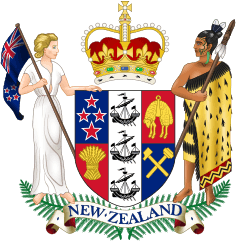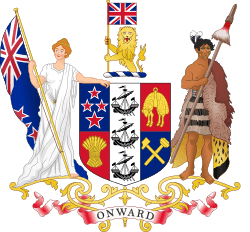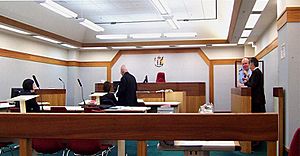Coat of arms of New Zealand facts for kids
Quick facts for kids Coat of arms of New Zealand |
|
|---|---|
 |
|
| Versions | |

1911–1956
|
|
| Armiger | Elizabeth II in Right of New Zealand |
| Adopted | 1956 |
| Blazon | Quarterly, Azure and Gules on a Pale Argent three Lymphads Sable. In the first quarter, four Mullets in cross of the last, each surmounted by a Mullet of the second (representing the Constellation of the Southern Cross); in the second quarter, a Fleece; in the third, a Garb; and in the fourth, two Mining Hammers in Saltire all Or. |
| Supporters | On the dexter side, a female figure proper vested Argent supporting in the dexter hand a Flag-staff proper, hoisted thereon the Ensign of the Dominion of New Zealand, and on the sinister side a Maori [sic] Rangatira vested proper holding in his dexter hand a Taiaha all proper. |
| Compartment | Silver fern leaves |
| Motto | "New Zealand" |
The coat of arms of New Zealand (in Māori: Te Tohu Pakanga o Aotearoa) is an important symbol for the country of New Zealand. It shows New Zealand's history as a nation with two main cultures: European and Māori. On one side, there is a European woman. On the other side, there is a Māori rangatira (chief).
The symbols on the shield in the middle show New Zealand's farming, industry, and trade. A Crown on top represents that New Zealand is a constitutional monarchy. This means it has a King or Queen as its head of state.
The first coat of arms was approved by King George V in 1911. The current version was approved by Queen Elizabeth II in 1956. The New Zealand Government mainly uses the coat of arms. You can see it on police uniforms and on the cover of New Zealand passports.
History and Design
Before 1911, New Zealand used the same royal coat of arms as the United Kingdom. In 1907, New Zealand became a "Dominion." This meant it was a self-governing country within the British Empire. Because of this, New Zealand decided it needed its own coat of arms.
A competition was held in 1908 to design the new symbol. James McDonald, a designer, created the winning entry. After some small changes, King George V officially approved the design on 26 August 1911.
The main part of the coat of arms, the central shield, has stayed almost the same since 1911. However, some other parts were changed in 1956.
What the Symbols Mean
The shield is divided into four sections.
- The top left section shows four stars. These stars represent the Southern Cross constellation, which you can see in the night sky over New Zealand. It's also on the national flag.
- The top right section has a golden fleece. This symbol represents New Zealand's important farming industry, especially sheep farming.
- The bottom left section shows a sheaf of wheat. This stands for agriculture and growing crops.
- The bottom right section has two crossed hammers. These represent mining and other industries.
Across the middle of the shield, there is a vertical strip with three ships. These ships show how important sea trade is to New Zealand. They also represent the journey of all New Zealanders' ancestors who arrived by sea.
Before 1956, the coat of arms looked a bit different. The top part (called the crest) was the upper half of a lion holding the British Union Flag. The scroll at the bottom had the country's old motto, "Onward." Also, the fern leaves at the base were often more decorative.
The figures on the sides, called "supporters," were also slightly different. The woman had reddish-brown hair. Both figures faced straight forward instead of towards the shield. The woman is known as Zealandia, a symbol of New Zealand. The person who modeled for the Māori warrior is not known.
1956 Redesign
In 1947, a special group was formed to update and standardize the coat of arms. One concern was that the female supporter looked too much like a "Soviet heroine." After a new government was elected in 1949, the Attorney-General, Jack Marshall, took charge. He asked for the woman to be redrawn to look like Grace Kelly, a famous actress he admired.
Today, the shield is held up by two figures. On the left (from the shield's view), there is a blonde woman of European background holding the New Zealand flag. On the right, there is a Māori warrior holding a Taiaha (a traditional Māori weapon).
The shield is topped with the St Edward's Crown, which is the Crown of the Monarch of New Zealand. Below the shield, there are two silver fern leaves and a scroll with the words "New Zealand" on it.
The woman is often seen as a symbol of Zealandia. She was a common national symbol for New Zealand in the early 1900s. The coat of arms is also the main part of the Queen's Personal New Zealand Flag.
Use
The New Zealand government is the main user of the coat of arms. Sometimes, for special events like royal visits, other groups can use it temporarily. However, they must get permission from the Ministry for Culture and Heritage first.
Images for kids
See also
 In Spanish: Escudo de Nueva Zelanda para niños
In Spanish: Escudo de Nueva Zelanda para niños





